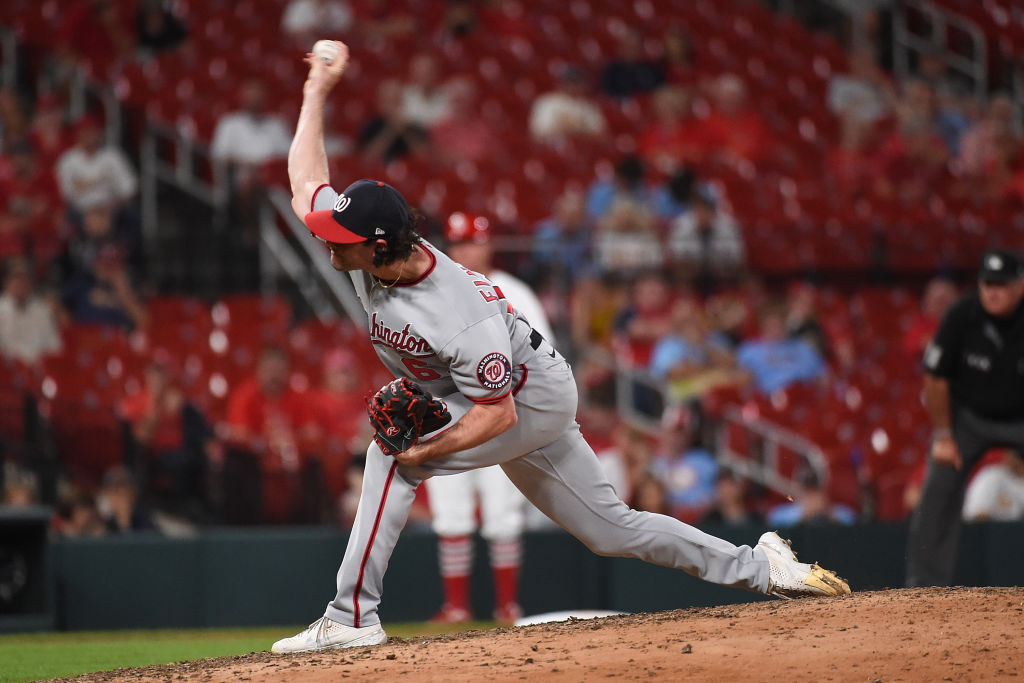Kyle Finnegan smiles when the subject comes up. He knows he’s one of the slowest-working pitchers in the majors. And he knows people assume that will become a major problem once he’s subject to a pitch clock next season.
Here’s what the Nationals closer wants you to know about that: He spent two seasons in the minor leagues with a pitch clock enforced and had no trouble adhering to it. But until he’s required to speed his process up, he’s not going to voluntarily do it.
“I think it’s just a product of taking what’s given to you,” he said earlier this week. “There’s no clock here, so why not make sure you’re ready to go?”
Nobody’s going to claim Finnegan isn’t giving himself enough time to make sure he’s ready. According to Baseball Savant, he averages 25.6 seconds between pitches when there’s nobody on base, fourth-slowest in the majors. With runners on base, that number goes up to 28.5 seconds, sixth-slowest in the sport.
(Important qualifier here: That “tempo” stat Baseball Savant uses tracks how long it takes from the time a pitcher releases the ball for one pitch until the time he releases it for the next pitch. The pitch clock that Major League Baseball will institute next year - 15 seconds with nobody on base, 20 seconds with runners on base - starts when the pitcher receives the throw-back from his catcher and ends when he begins his delivery. Accounting for that, Finnegan’s pace this season drops to 19.6 seconds with nobody on base, 22.5 seconds with runners on base.)
Finnegan is confident he’ll have little trouble speeding himself up next season.
“I pitched two years in the minor leagues with a pitch clock, and I think in the two years I had maybe one violation,” he said. “I would have no problem going faster, and I don’t see it being a problem for me.”
Looking at the tempo leaderboard, though, something else immediately becomes clear: All of the slowest-working pitchers are closers (Giovanny Gallegos, Kenley Jansen) or typically work the late innings of games as setup men (Jonathan Loaisiga, Andrew Bellatti).
When you stop to consider that, it makes perfect sense. The highest-leverage situations in a ballgame are probably going to make a pitcher take extra time. Any one pitch in those situations could be the difference between a win and a loss, so obviously he’s going to spend as much time as he can contemplating what pitch he wants to throw and where he wants to throw it, not to mention keeping any baserunners from taking too big a lead.
“A lot of it, for me, is just trying to think about the situation as a whole, what I want to throw to that guy in that particular moment,” Finnegan said. “And then really just that one extra breath. That one extra moment to make sure you give that pitch your best effort.
“But I could easily go faster if need be.”
There was plenty of hysteria when the minor leagues began using the pitch clock in 2015, and it took some time for everyone – both pitchers and batters, by the way – to adjust. But just about everyone figured it out, and by now most major leaguers already have some experience with it in their professional careers.
Every once in a while, a veteran trying to make his way back or making a rehab assignment gets thrown off by the clock. Tyler Clippard notably had all kinds of trouble when he first reported to Triple-A Rochester in April. But for the most part, the pitch clock has become routine for minor leaguers.
And the results have been staggering: According to MLB, the average time of minor league games has dropped by 26 minutes since the installation of the pitch clock, with no tangible impact on the results of those games.
Will there be some hysteria and lots of complaints next March and April when all major leaguers are subject to the clock for the first time, and certainly when somebody is called for an automatic ball for being too slow? Of course.
But as was the case with mandatory inspections for “sticky stuff” last summer, the hysteria faded away in short order, and hardly anybody notices it anymore.
Finnegan may prefer to have as much time as he needs when faced with a bases-loaded, two-out situation in the bottom of the ninth. But if he’s not allowed to do that, he’ll find a way to adhere to the rules.
“I would say it’s mixed reviews (among all players since the announcement),” he said. “You don’t want it to affect guys in a negative way. But I think if you asked everybody if they could make the game quicker, would they? They probably would. I don’t think it’s really a huge deal, and I think that’s kind of been the consensus.”
By accepting you will be accessing a service provided by a third-party external to https://www.masnsports.com/





